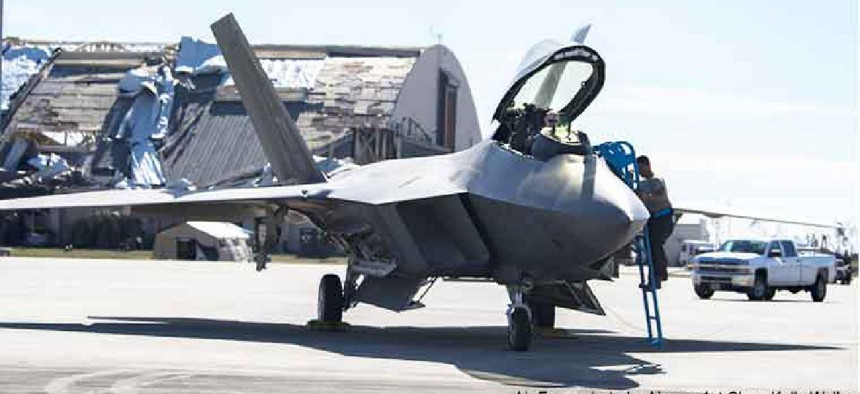If you could build an Air Force base from scratch…
AFWERX's Base of the Future showcase will take advantage of the nearly wholesale rebuilding of Tyndall Air Force Base in Florida.
AFWERX, the Air Force's catalyst for innovation, has announced challenges and workshops associated with its Base of the Future showcase that takes advantage of the nearly wholesale rebuilding of Tyndall Air Force Base in Florida that was severely damaged by Hurricane Michael in 2018.
“With the rebuild of Tyndall Air Force Base, the Air Force has an opportunity to create from scratch an installation that will be recognized as a center of excellence for innovation,” according to a notice posted to the beta.SAM.gov.
"Increasing installation facility standards to not only ensure buildings meet resiliency expectations, but also look and feel like 21st-century facilities is of vital importance to the rebuild," Project Manager Col. Travis Leighton said at a Jan. 23 town hall meeting to discuss the “Installation of the Future” with airmen, their families and base personnel.
“These standards will incorporate smart-building sensors, increased hurricane wind load levels, and design flood elevation specifications,” Leighton said. “But even the architectural designs will support energy efficiency and structural resilience.”
AFWERX will host five workshops, focusing on delivering emerging technologies and innovative strategies for the next-generation Air Force.
The culture of innovation workshop addresses improving workforce agility and breaking down barriers to change. From bad Wi-Fi to outdated hardware, legacy technology has hampered mission success, and AFWERX wants to remove obstacles in hardware, networking and contracting. It also aims to bolster a culture of innovation, improve workforce agility and increase communication and engagement of service members across Air Force bases.
The base security and defense workshop will examine enhancing security and strengthening perimeter defenses to protect people and critical resources from active shooters, explosives, cyber risks and other threats. AFWERX wants to discuss how drones can be leveraged to patrol large perimeters, credential verification and access denial protocols can be improved and the capabilities of virtual control centers, cameras, sensor systems and video analytics increased.
To figure out how to reverse engineer obsolete parts from paper drawings, the 2D to 3D designs for additive manufacturing workshop will explore what's required to 3D print critical equipment from scanned 2D drawings.
Leveraging technology for operational effectiveness for the base of the future requires leadership and expertise in operational technology, automation, artificial intelligence, digital integration and cybersecurity. This workshop aims to explore how mixed reality and additive manufacturing can enhance operations, how emergency operations center can collect and analyze data from facility control systems and how users can leverage artificial intelligence and machine learning to provide actionable information. AFWERX also hopes to learn how condition-based maintenance systems can improve flight line operations.
As Hurricane Michael demonstrated, Air Force installations must be resilient against all types of natural disasters. In this resilience workshop, AFWERX wants to address how an installation can improve its durability in the face of high-impact weather, maintain power through natural disasters and cyberattacks and quickly recover after damage occurs. It is also looking at optimizing central operations to collect and analyze data from installed systems and other utilities.
“We are not just rebuilding Tyndall AFB,” Col. Brian Laidlaw, commander of 325th Fighter Wing, said at the town hall meeting. “We are not rebuilding the base we had, but the base we need for the future. Part of what makes Tyndall so valuable for our nation is not just what it can handle today, but the potential it has for the future.”
This article first appeared on GCN, a partner site with Defense Systems.





